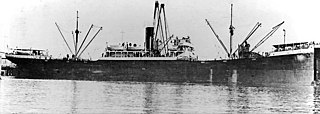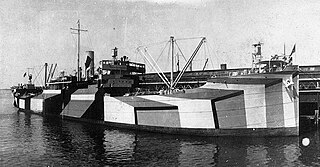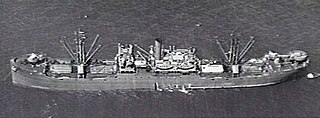
USS George F. Elliott (AP-13) was a Heywood-class transport acquired by the U.S. Navy during World War I and then reacquired by the Navy for service as a troop carrier during World War II. In 1942, she was attacked off Guadalcanal by Japanese planes and sank shortly thereafter.

The SS Empire Miniver was a British steam merchant ship. She was originally an American merchant, launched in 1918 as SS West Cobalt. During a brief stint in the United States Navy in 1919, she was known as USS West Cobalt (ID-3836).

SS Point Bonita was constructed in 1918 and launched 27 March 1918 after a hull being built for foreign owners at Albina Engine and Machine Works was requisitioned during World War I by the United States Shipping Board (USSB). The ship saw service as the Navy transport USS Point Bonita, assigned Identification Number 3496, from 7 October 1918 to 7 April 1919, was returned to the USSB and saw civilian service with several commercial companies as San Pedro and Oliver Olson before again seeing service in World War II as USS Camanga (AG-42). After return to commercial service as Oliver Olson the ship was wrecked at the entrance to Bandon harbor in Oregon.

USS Tuluran (AG-46) was under construction for the British at the Toledo Shipbuilding Company as the cargo ship War Bayonet in 1917 when requisitioned by the United States Shipping Board (USSB) for World War I service. The ship was launched and completed as Lake Superior. The Navy acquired the ship from the USSB with assignment to the Naval Overseas Transport Service (NOTS) with the identification number ID-2995. The ship was returned to the USSB which sold the vessel in 1926. The ship was renamed C. D. Johnston III and that vessel operated out of Oregon until again sold and based in San Francisco. Another sale resulted in the vessel being renamed Anna Shafer which was acquired by the War Shipping Administration (WSA) in 1942 and allocated to the Navy for World War II service.

USS West Alsek (ID-3119) was a cargo ship in the United States Navy during World War I. She had been built as SS West Alsek for the United States Shipping Board (USSB) as part of the West boats, cargo ships built on the West Coast of the United States. She sailed on two voyages for the U.S. Navy before she was decommissioned after the Armistice.

USS West Apaum (ID-3221) was a cargo ship in the United States Navy during World War I. She had been built as SS West Apaum for the United States Shipping Board (USSB) as part of the West boats, a series of steel-hulled cargo ships built on the West Coast of the United States.

USS West Avenal (ID-3871) was a cargo ship in the United States Navy during World War I. She had been built as SS West Avenal for the United States Shipping Board (USSB) as part of the West boats, a series of steel-hulled cargo ships built on the West Coast of the United States. West Avenal was launched in October 1918 by the Western Pipe and Steel Company of San Francisco, California, and delivered to the US Navy when she was completed in February 1919. After she was commissioned and had taken on a load of flour, West Avenal sailed to Norfolk, Virginia, where she was decommissioned in early April.

USS West Carnifax (ID-3812) was a cargo ship in the United States Navy shortly after World War I. After she was decommissioned from the Navy, the ship was known as SS West Carnifax, SS Exford, and SS Pan Royal in civilian service under American registry.

Seisho Maru was a cargo ship for Mitsui Bussan Kaisho in military service that was sunk by an American submarine during World War II. The ship had been built as SS West Caruth, a cargo ship for the United States Shipping Board (USSB) shortly after the end of World War I. Shortly after completion, the ship was inspected by the United States Navy for possible use as USS West Caruth (ID-2850) but was neither taken into the Navy nor ever commissioned under that name. Before being sold to Japanese owners in 1928, she was also known as SS Exmoor and SS Antonio Tripcovich.

MS West Grama, sometimes spelled as West Gramma, was a diesel-powered cargo ship of the United States Maritime Commission (USMC) that was sunk as part of the "gooseberry" breakwater off Utah Beach during the Normandy invasion. Prior to her diesel conversion, she was known as SS West Grama. In 1919, she was briefly taken up by the United States Navy under the name USS West Grama (ID-3794).

West Compo was a steam cargo ship built in 1918–1919 by Northwest Steel Company of Portland for the United States Shipping Board as part of the wartime shipbuilding program of the Emergency Fleet Corporation (EFC) to restore the nation's Merchant Marine. The vessel was commissioned into the Naval Overseas Transportation Service (NOTS) of the United States Navy in January 1919 and after only one overseas trip was decommissioned four months later and returned to the USSB. Afterwards the vessel was largely employed on the Atlantic Coast of the United States to France route until mid-1921 when she was laid up and eventually broken up for scrap in 1936.

USS West Corum (ID-3982) was a cargo ship for the United States Navy in 1919. The ship was built as SS West Corum and reverted to that name at the end of her Navy service. During World War II, the ship was United States Army transport ship USAT West Corum, later renamed to Will H. Point.

The Columbia River Shipbuilding Company was a small shipyard in Portland, Oregon, United States, located on the west bank of the Willamette River. The shipyard was located at the foot of SW Sheridan Street, just upstream of the Interstate 5 Marquam Bridge, directly adjacent to the Northwest Steel shipyard.

USS West Gate (ID-3216) was a cargo ship for the United States Navy during World War I. The ship was laid down as SS War Agate, but she was launched in January 1918 as SS West Gate instead.

USS West Ekonk (ID-3313) was a cargo ship for the United States Navy during World War I. She was later known as SS West Ekonk in civilian service under American registry, and as SS Empire Wildebeeste under British registry.

USS Morristown (ID-3580) was a cargo ship that served in the United States Navy during World War I, from 1918 to 1919.
Wassaic was a steam cargo ship built in 1918-1919 by Los Angeles Shipbuilding & Dry Dock Company of San Pedro for the United States Shipping Board (USSB) as part of the wartime shipbuilding program of the Emergency Fleet Corporation (EFC) to restore the nation's Merchant Marine.

SS Lake Arthur (ID-2915) was a Design 1020 cargo ship that served in the Naval Overseas Transportation Service (NOTS) of the United States Navy during World War I. Originally ordered and begun under the name SS War Plum, she was renamed SS Lake Arthur by the United States Shipping Board (USSB). After her naval service, she operated commercially under a variety of names, before being scuttled in the North Sea with a load of chemical weapons in November 1945.

SS West Hosokie was a steel–hulled cargo ship built in 1918 as part of the World War I emergency wartime shipbuilding program organized by the United States Shipping Board.

SS West Mahomet was a steel–hulled cargo ship which saw service as an auxiliary with the U.S. Navy in 1918-19.















